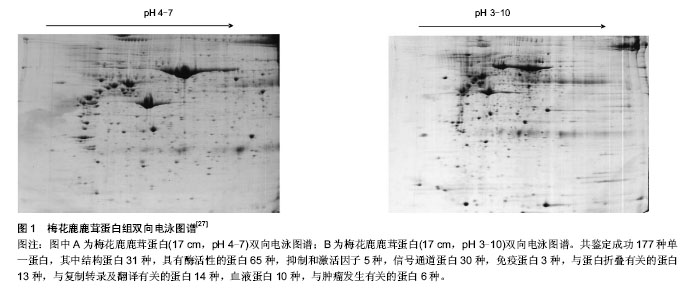| [1] Sunwoo HH, Nakano T, Hudson RJ, et al. Isolation, characterization and localization of glycosaminoglycans in growing antlers of wapiti (Cervus elaphus). Comp Biochem Physiol B Biochem Mol Biol. 1998;120(2):273-283.
[2] Sunwoo HH, Nakano T, Sim JS.Isolation and characterization of proteoglycans from growing antlers of wapiti (Cervus elaphus). 1998;121(4):437-442.
[3] Li C, Yang F, Sheppard A. Adult stem cells and mammalian epimorphic regeneration-insights from studying annual renewal of deer antlers. Curr Stem Cell Res Ther. 2009; 4(3): 237-251.
[4] Li C, Pearson A, McMahon C.Morphogenetic mechanisms in the cyclic regeneration of hair follicles and deer antlers from stem cells.Biomed Res Int. 2013;2013:643601.
[5] Gao Z, Li C. The study on the relationship between antler’s growth rate, relative bone mass and circulation testosterone, estradiol, AKP in sika deer. Acta Vet Zootech Sin. 1988;19: 224-231.
[6] Unsal C, Oran M, Tureli HO, et al. Detection of subclinical atherosclerosis and diastolic dysfunction in patients with schizophrenia. Neuropsychiatr Dis Treat. 2013;9:1531-1537.
[7] Garcia M, Charlton BD, Wyman MT, et al. Do Red Deer Stags (Cervus elaphus) Use Roar Fundamental Frequency (F0) to Assess Rivals? PLoS One. 2013;8(12):e83946.
[8] Clark DE, Li C, Wang W, et al. Vascular localization and proliferation in the growing tip of the deer antler. Anat Rec A Discov Mol Cell Evol Biol. 2006;288(9):973-981.
[9] Li C. Deer antler regeneration: a stem cell-based epimorphic process. Birth Defects Res C Embryo Today. 2012;96(1): 51-62.
[10] Kierdorf U, Kierdorf H, Szuwart T.Deer antler regeneration: cells, concepts, and controversies.J Morphol. 2007;268(8): 726-738.
[11] Li C, Harper A, Puddick J, et al. Proteomes and signalling pathways of antler stem cells.PLoS One. 2012;7(1): e30026.
[12] Price JS, Allen S, Faucheux C,et al.Deer antlers: a zoological curiosity or the key to understanding organ regeneration in mammals?J Anat. 2005;207(5):603-618.
[13] Li W, Ding S. Converting mouse epiblast stem cells into mouse embryonic stem cells by using small molecules. Methods Mol Biol. 2013;1074:31-37.
[14] Zhou H, Li W, Zhu S, Joo JY,et al.Conversion of mouse epiblast stem cells to an earlier pluripotency state by small molecules.J Biol Chem. 2010;285(39):29676-2980.
[15] Yang C, Przyborski S, Cooke MJ, et al. A key role for telomerase reverse transcriptase unit in modulating human embryonic stem cell proliferation, cell cycle dynamics, and in vitro differentiation. Stem Cells. 2008;26(4):850-863.
[16] Beekman C, Nichane M, De Clercq S, et al. Evolutionarily conserved role of nucleostemin: controlling proliferation of stem/progenitor cells during early vertebrate development. Mol Cell Biol. 2006;26(24):9291-9301.
[17] Li C, Yang F, Sheppard A. Adult stem cells and mammalian epimorphic regeneration-insights from studying annual renewal of deer antlers. Curr Stem Cell Res Ther. 2009; 4(3):237-251.
[18] Rolf HJ, Kierdorf U, Kierdorf H, et al. Localization and characterization of STRO-1 cells in the deer pedicle and regenerating antler. PLoS One. 2008;3(4):e2064.
[19] Berg DK, Li C, Asher G, et al. Red deer cloned from antler stem cells and their differentiated progeny. Biol Reprod. 2007;77(3):384-394.
[20] Kierdorf U, Kierdorf H. Deer antlers - a model of mammalian appendage regeneration: an extensive review. Gerontology. 2011;57(1):53-65.
[21] Kierdorf U, Li C, Price JS. Improbable appendages: Deer antler renewal as a unique case of mammalian regeneration. Semin Cell Dev Biol. 2009;20(5):535-542.
[22] Li C.Exploration of the mechanism underlying neogenesis and regeneration of postnatal mammalian skin-deer antler velvet. Int J Med Biol Front. 2010;11/12(16):1-19.
[23] Li C, Suttie JM. Tissue collection methods for antler research. Eur J Morphol. 2003;41(1):23-30.
[24] Li C, Yang F, Li G, et al. Antler regeneration: a dependent process of stem tissue primed via interaction with its enveloping skin. J Exp Zool A Ecol Genet Physiol. 2007; 307(2):95-105.
[25] Wang P, Zhang C, Zhu Y, et al. The resolution and regeneration of a cointegrate plasmid reveals a model for plasmid evolution mediated by conjugation and oriT site-specific recombination. Environ Microbiol. 2013;15(12): 3305-3318.
[26] Hsueh YY, Chang YJ, Huang TC, et al. Functional recoveries of sciatic nerve regeneration by combining chitosan-coated conduit and neurosphere cells induced from adipose-derived stem cells. Biomaterials. 2014;35(7):2234-2244.
[27] 赵东.梅花鹿鹿茸双向电泳体系建立及蛋白质组学的研究[D].江苏科技大学,2012.
[28] 赵东.梅花鹿鹿茸总蛋白提取方法对双向电泳图谱的影响[J].中国畜牧兽医,2012,39(7):25-28.
[29] 刘华淼,邢秀梅,杨福合. 梅花鹿鹿茸双向电泳蛋白提取条件筛选[J]. 特产研究,2013,(02):5-6+22.
[30] 丁倩南,王春梅,戴俊东,等. 梅花鹿鹿茸不同部位蛋白双向电泳谱图比较[J]. 中药材,2013,36(4):521-525.
[31] Park HJ, Lee DH, Park SG, et al. Proteome analysis of red deer antlers. Proteomics. 2004;4(11):3642-3653.
[32] Price J, Faucheux C, Allen S. Deer antlers as a model of Mammalian regeneration. Curr Top Dev Biol. 2005;67:1-48.
[33] 徐代勋. 梅花鹿鹿茸角柄骨膜不同部位差异蛋白的筛选[D].江苏科技大学,2011.
[34] 徐代勋,王桂武,赵海,等. 梅花鹿角柄骨膜蛋白质组学初步研究[J]. 特产研究,2011,33(1):1-4.
[35] 祁伟祥,姚阳,沈赞. 色素上皮衍生因子抗肿瘤治疗的研究进展[J]. 中国肿瘤临床,2011,38(8):477-480.
[36] 文灿,余汇洋. Fibulin-5与肿瘤的研究进展[J]. 局解手术学杂志, 2006,15(5):337-338.
[37] Lord EA, Martin SK, Gray JP, et al. Cell cycle genes PEDF and CDKN1C in growing deer antlers. Anat Rec (Hoboken). 2007;290(8):994-1004.
[38] Wang X, Song X, Zhuo W, et al. The regulatory mechanism of Hsp90alpha secretion and its function in tumor malignancy. Proc Natl Acad Sci U S A. 2009;106(50):21288-21293.
[39] 高亮,乔晓强,梁振,等. 基于在线二维色谱的不同生长时期鹿茸的比较蛋白质组分析[J].色谱,2010,28(2):146-151.
[40] Gao L, Tao D, Shan Y, et al. HPLC-MS/MS shotgun proteomic research of deer antlers with multiparallel protein extraction methods. J Chromatogr B Analyt Technol Biomed Life Sci. 2010;878(32):3370-3374.
[41] Sui Z, Yuan H, Liang Z, et al. An activity-maintaining sequential protein extraction method for bioactive assay and proteome analysis of velvet antlers. Talanta. 2013;107: 189-194.
[42] 高亮,鹿茸蛋白质的提取及差异研究[D].中国科学院研究生院, 2010.
[43] Unlü M, Morgan ME, Minden JS. Difference gel electrophoresis: a single gel method for detecting changes in protein extracts. Electrophoresis. 1997;18(11):2071-2077. |
